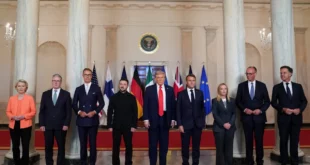Washington Must Choose Between Primacy and Prioritizing
The Biden administration took office intending to inject strategic focus into U.S. foreign policy. The president and his team promised to end the United States’ forever wars and make the country’s international engagements serve the needs of a disaffected public. In its first year, the administration terminated the two-decade-old war in Afghanistan, pledged to “right-size” the U.S. military presence in the Middle East, and even pursued a “stable and predictable” relationship with Russia. By placing less emphasis on certain regions, the logic went, Washington could concentrate on what most affects U.S. interests: managing competition with China and tackling transnational threats such as climate change and pandemics.
Today that vision lies in tatters. The United States is now immersed in multiple wars in Europe and the Middle East, precisely where the administration sought to keep things quiet. Meanwhile, relations with China and Russia have deteriorated so strikingly as to raise the realistic prospect of the first major-power conflict since 1945.
One can hardly blame U.S. policymakers for the turmoil. It was Russian President Vladimir Putin who decided to invade Ukraine in 2022, and Hamas that chose to attack Israel in 2023. No one had a crystal ball to predict these shocking actions years in advance. Yet American officials bear responsibility for making a failed wager of their own. They hoped entire regions of the world would sit still because they preferred to turn their gaze elsewhere, even as the United States remained ensconced in those regions’ security arrangements. The Biden administration wanted to prioritize what in its view mattered most while declining to disentangle the United States from what mattered less.
This is a form of wishful thinking—perhaps as naive as invading countries to liberate them—and ought to be recognized as such. The Biden administration is not the first to indulge in it. The rationale for American global dominance after the Cold War, as articulated by the Pentagon in 1992, was that by maintaining military primacy in most world regions, the United States would suppress competition among other countries, dissuade challengers from emerging, and keep the peace at a reasonable cost to Americans. But the unipolar era is over. Going forward, the options are stark: the United States can selectively retrench and control costs and risks, or it can stick with global primacy and lurch from crisis to crisis.
NO HARD CHOICES
From his inauguration through the autumn of 2021, U.S. President Joe Biden appeared to consider pulling U.S. forces back from the Middle East and possibly elsewhere. He initially directed the Defense Department to review the United States’ global force posture and align it with the priorities defined by the White House. Then, in August 2021, he ended the war in Afghanistan. Yet specific circumstances had largely forced Biden’s hand: along with an agreement reached by his predecessor to withdraw from the country, he inherited so few troops there that he would have had to escalate the failing and unpopular war effort if he did not pull out. By November, the Pentagon had announced that the U.S. force posture, having been duly reviewed, was basically correct.
Ever since, the Biden administration has avoided making structural reductions to any portion of U.S. global primacy—to the political objectives, defense commitments, and military positions that Washington has accumulated over eight decades. At the same time, it has continued to try to set priorities, privileging security requirements in the Indo-Pacific above those in Europe and the Middle East. In its National Security Strategy, released in October 2022, the terms “priority,” “priorities,” and “prioritize” appear 23 times, even as the United States’ globe-spanning alliances and partnerships are described as “our most important strategic asset,” tantamount to ends in themselves. In essence, the administration wished to keep certain regions off the president’s desk while remaining the paramount security actor in those same places.
There are two possible ways to make sure low-priority regions stay that way, in the absence of any changes to U.S. objectives, commitments, or positions. First, the United States could employ deft diplomacy to accommodate the grievances of actors such as Iran and Russia that seek to revise the status quo in their favor. But U.S. diplomats could offer only modest measures if they were prohibited from paring back the United States’ core ambitions, security partnerships, or forward deployments. Alternatively, the United States could try to convince its allies and partners that they, not Washington, would have to take primary responsibility for managing any conflicts that arose in their own neighborhoods. Yet if the United States cared so much that it chose to remain the region’s premier military power, why would it care so little that it would stand back in a crisis? The message would be awfully difficult to make credible.
In its first year, the Biden administration opted for a halfhearted combination of both inadequate options. It attempted to mollify rivals through diplomacy and coax allies and partners to step up—in practice falling back on the hope that the status quo would somehow hold. In the Middle East, Biden initially aimed to rejoin the nuclear deal with Iran that his predecessor had abandoned in 2018 and gave the cold shoulder to Saudi Arabia. But the administration could never decide whether it wanted to pay the political costs of reviving the accord, and negotiations fell apart as Washington pursued a “longer and stronger” agreement and Tehran sought new concessions and guarantees that the United States would not withdraw again in the future. The Saudi snub, mostly atmospheric, was easily reversed by Biden’s second year.
Biden positioned himself as the restorer of normality after Trump.
More fundamentally, the Middle East is so complex and unstable, comprising numerous states and armed groups able and willing to challenge the status quo, that even ambitious diplomatic efforts to ease tensions among some parties end up exacerbating tensions among others. Consider the fate of the Abraham Accords, the U.S.-brokered agreements between Israel and a handful of Arab countries to normalize relations. By embracing the accords and seeking last summer to expand them to include a deal between Israel and Saudi Arabia, the Biden administration was in a sense promoting integration and peace, but only among opponents of Iran and its proxies. And the move came at the price of diminishing the political prospects of Palestinians—who, under the Arab Peace Initiative of 2002, were supposed to achieve statehood as a condition of Arab governments normalizing relations with Israel. The Palestinians’ vanishing political horizon was likely an impetus for Hamas’s attack in southern Israel on October 7.
The Biden administration never put as low a priority on Europe as it did on the Middle East. In its first year, however, it reached out to Moscow in the hopes of establishing a “stable and predictable” relationship with Russia that could permit Washington to focus on strategic competition with China. Biden held a summit with Putin in June 2021, and the two countries launched a strategic stability dialogue with the aim of reducing the risk of nuclear war and enhancing arms control. But the White House underestimated Russia’s revisionist ambitions and refused to negotiate over NATO’s relationship with Ukraine, an issue that would have had to be addressed for there to be any chance of getting Putin to shelve his invasion plans.
Eager to embrace U.S. allies after the Trump years, the Biden administration did little to encourage European states to bear the bulk of the transatlantic defense burden. “America is back,” the president proclaimed. Rather than capitalize on the possibility that Donald Trump might return to office, Biden positioned himself as the restorer of normality after a Trumpian aberration. The United States remained Europe’s security provider of first resort, one crisis away from having to manage the response.
The point is not that the Biden administration could have made better diplomatic efforts, short of retrenchment, that would have prevented it from ultimately getting diverted to Europe or the Middle East. To the contrary, any such attempt was bound to fail. The accommodations necessary to satisfy U.S. rivals, and the inducements required to get allies and partners to solve problems themselves, would compel the United States to practice some measure of retrenchment. Only by pulling back—by trimming its political objectives and defense obligations, and the military posture that supports them—can Washington plausibly keep Europe and the Middle East crisis-free, at least for the United States. If this was true when Biden took office, it is only more applicable now that Russia is more isolated from and hostile toward the West and the Israel-Hamas war has triggered widespread conflict in the Middle East.
SHEDDING BURDENS
As its plans for prioritization have come undone, the Biden administration has improvised something of a fallback, indicating the direction it may travel in a second term. In lieu of retrenching, it is seeking to build “connective tissue” between U.S. allies in Europe and Asia. By knitting the two theaters together, the argument goes, Washington can be more effective in each one and stimulate what Jake Sullivan, the U.S. national security adviser, claims is “the greatest amount of burden sharing in decades.”
Unfortunately, although cooperation among allies is welcome, this approach is unlikely to reduce or limit the overall costs and risks the United States bears for defense. To keep its burdens from growing, allies would have to assume responsibilities and develop capabilities that replace those of the United States and outpace the threats to regional security from China and Russia. In neither region does this seem to be happening. Boosts to European and Japanese military spending, although substantial, still translate into limited capabilities, which are meant to augment more than replace U.S. forces and fall short of offsetting China’s rising power and Russia’s more aggressive intentions. The White House, for its part, has not articulated metrics by which to gauge the success of its cross-regional strategy over time. The effort may end up providing a convenient alibi for maintaining U.S. global primacy in full and giving up on prioritizing altogether.
Burden sharing is no substitute for burden shifting. If the United States truly wants to set priorities according to its interests—in other words, to act strategically—there is no viable alternative to pulling back from the places that matter less. Washington cannot reap the benefits of caring less without actually caring less and downsizing U.S. objectives, commitments, and positions accordingly. Rather than lump overseas areas together into a grand, U.S.-led battle space, Washington should differentiate among regions and establish clear divisions of labor between itself and its security partners. This means systematically disentangling the United States from the Middle East, shifting most of the European defense burden onto European allies, and working to establish competitive coexistence with China so that the political and economic relationship between the two countries stabilizes while the United States continues to use military power to prevent a Chinese bid for regional hegemony.
Such a formula may constitute the only basis for forging a new foreign policy consensus in American politics to replace the tottering primacist paradigm. It could become broadly acceptable to the progressive left, with its antiwar and antiauthoritarian leanings; to centrists who seek great-power competition without catastrophe; and to the “America first” right, opposed to Chinese belligerence and the free-riding of allies. If, by contrast, the United States continues to chase global primacy even as that endeavor becomes untethered from politics at home, it will stake too much of the world’s security and its own prestige on the outcome of each U.S. election. Finding a durable foreign policy consensus is essential to sustaining any coherent strategy and keeping commitments credible.
Burden sharing is no substitute for burden shifting.
For the first time in the post–Cold War era, establishing the desirability of retrenchment might be the easy part. Implementing a course correction, however, will be extremely difficult, given the political interests and ideological axioms that currently support primacy. A president would need to take office determined to retrench and prepared to spend political capital to do so. He or she could not be dissuaded by setbacks, such as the Taliban’s takeover of Afghanistan after the U.S. withdrawal. A cadre of senior officials would have to formulate policy frameworks spanning four to eight years and ensure that the bureaucracy buys in and follows through. The administration could not let the momentary absence of crises keep it from advancing its agenda. For example, the Trump and Biden administrations should have removed U.S. ground forces from Iraq and Syria once their mission to defeat the Islamic State was complete, instead of leaving those troops in place as ready targets for pro-Iranian militias once tensions mounted. And when crises do arise, the administration should turn them into opportunities to pull the United States further out rather than drag it deeper in.
In the Middle East, even a responsible pullback could have destabilizing consequences in the short run. A retrenchment president would need to explain that the region’s volatility illustrates why the United States is moving to a largely offshore role, and that the Middle East must have a chance to find its own equilibrium, as the presence of multiple middle-weight powers allows it to do. By retaining a few air and naval bases, perhaps in Bahrain and Qatar, the United States could continue to secure the maritime commons, its vital interest in the region that is permanent rather than circularly created by its presence there. Because the United States lacks treaty allies in the region, aside from Turkey, the president could downgrade security partnerships into more neutral and transactional relationships without abrogating legal obligations.
Retrenchment from Europe presents a different challenge: the downside risk is more deleterious to U.S. interests but the odds of an ideal outcome—an orderly transition to European leadership of European defense—are higher than they are in the Middle East. The war in Ukraine has made the transition more feasible by spurring European allies to spend more on defense and, despite Biden’s efforts, by showing them the danger of depending on the whims of Washington. While Russian forces remain concentrated in Ukraine, the transatlantic alliance has a unique opportunity to shift the bulk of the defense burden onto the EU and the European members of NATO without allowing Moscow a window of opportunity for further aggression. A retrenchment president would strike a new bargain that keeps the United States within NATO but over a decade steadily replaces most U.S. forces and capabilities with European ones.
Barring a volte-face, the Biden administration will not adopt this approach if it wins a second term. But it should, and its successors still could. The revival of confidence in U.S. primacy following Russia’s invasion of Ukraine has proved short-lived, and the generations of Americans with no memory of the Cold War are coming into power. To preserve the possibility of responsible retrenchment, however, Biden must not take on new defense obligations. A treaty binding the United States to defend Saudi Arabia, as he is now weighing, would damage U.S. interests, even in exchange for the normalization of Saudi relations with Israel and Israeli steps toward a Palestinian state. The administration should also hold firm against inviting Ukraine to join NATO and instead prepare to equip the country to defend itself over the long run.
AFTER PRIMACY
If Trump returns to the White House next year, he could potentially become a retrenchment president, but he would have to change much of his outlook and conduct. In his first term, U.S. alliance commitments and defense spending only expanded. For all his ally-bashing, Trump mainly aimed to wring a better deal out of existing security arrangements, not to retract them. Unless he demonstrates a stronger and more consistent preference for retrenchment and appoints appropriate personnel, a second Trump administration might well resemble the first. Trump’s pledge to restore “peace through strength”—his mantra on the campaign trail—partakes in the very fantasy that has brought U.S. foreign policy to this low point. In fact, no amount of American strength will make the rest of the world cower in fear and accept peace on Washington’s terms.
And that is just fine. The United States does not need global military dominance in order to thrive. What it must do is rescue its liberal democracy, rebuild its party politics, and restore the confidence of its people. Clinging to primacy sets back this great task. It creates a foreign policy that is perpetually out of control, and a country that is losing its sense of self-control. More than any major power, the United States, endlessly innovative, militarily peerless, shielded by two oceans and nuclear deterrents, should be master of its fate. It should look out at the world and see opportunities to seize and choices to make. Great nations set priorities.
 Eurasia Press & News
Eurasia Press & News




